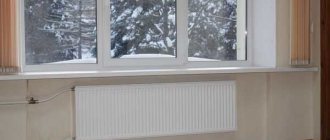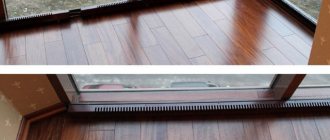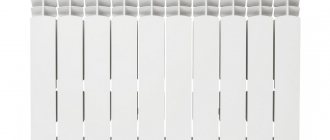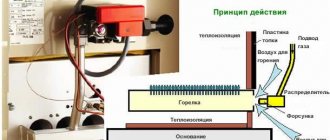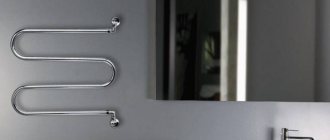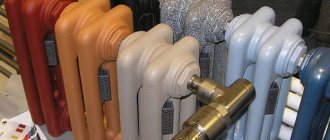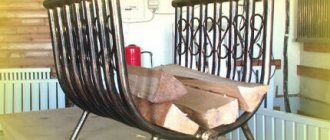PRADO steel heating radiators are technologically advanced and aesthetic designs that are suitable for apartments and private houses, industrial and public premises, as well as industrial buildings.
Prado products are manufactured by the domestic enterprise OJSC NITI Progress , which is located in Izhevsk . The batteries are not inferior in quality to foreign analogues. They are used in one- and two-pipe water heating systems and fully comply with GOST requirements.
Why is it profitable to make heated floors?
The main advantage of heated floors over all other types of heating is that they are hidden from view and are ideal for families with small children.
In addition to the fact that babies can crawl safely, they will not get burned on heat sources that are securely hidden under the finishing coating. There are no drafts in the room where heated floors are installed. Warm floors reduce heating costs in houses with very high ceilings, where it is difficult to rationally organize heating of the entire volume of the room. In apartments located on the ground floor, above damp, cold basements, heated floors will provide a comfortable microclimate.
In addition, they do not dry out the air, which is especially appreciated by sensitive people prone to allergies. When heated floors are an autonomous type of heating, they will help out on cold days in the off-season. Ceramic tiles, even with the best heating system, remain cold, and here the use of warm floors will help out.
Thus, the decision to install heated floors is for the benefit of the health of family members
It is important to choose which system is best to use
Range
Currently, the manufacturer produces 3 model lines of radiators under the Prado brand.
The first series - Prado Classic - is equipment with walls on the sides and special grilles that are mounted on top of the radiator to release heated air. The battery connection is made from the side.
The second series - Prado Universal - is distinguished by two options for connecting to the heating system. All devices in the line, equipped with an integrated thermostat, have 4 inputs on the side and a connection at the bottom. The options differ in the side on which the connection is made - it can be left or right.
Sanitary versions of the above series - Prado Classic Z and Prado Universal Z - make up the third model line. As a rule, they are used in medical institutions. Therefore, a feature of models with the “Z” index is the absence of additional fins in their design, as well as covers on the top and sides.
Radiator Prado Classic Z series
It is worth noting that Classic radiators can be installed in systems with any type of wiring. At the same time, Universal series devices are equipped with two-pipe circuits.
Hygienic rulers
Traditional radiators, including those from Prado, raise dust into the air. They work like convectors, sucking in cold air from below and throwing it out through the top grille. A huge amount of dust settles on the internal surfaces, which are replete with scattering ribs. Under the influence of convection currents, it gradually spreads throughout the premises, settling on surfaces.
There is a separate category of premises that have special cleanliness requirements. These are hospital wards, operating rooms, laboratories, medical and treatment rooms. Wet cleaning is carried out here regularly to get rid of dust. Nevertheless, it remains in them, but in small quantities. To prevent dust from spreading throughout the premises, they use hygienic radiators, including those from the Prado company.
Consumers can choose from two lines of Prado hygienic radiators - Classic and Universal with the Z index. Features of these devices:
- Side and bottom supply at the consumer's choice.
- No fins.
- No top grill.
- Reduced thermal output.
Their power is really reduced - this is due to the lack of fins. The types of radiators produced are 10Z, 20Z and 30Z. Dimensions in length - from 400 to 3000 mm, in height - 300 or 500 mm. Power for models with a height of 300 mm varies from 364 to 3171 W, for models with a height of 500 mm - from 535 to 4663 W.
Technical characteristics and scope of application
Prado radiators are made of steel alloys, and they are susceptible to corrosive processes, so they can only be used when installing closed-type heating systems. In this case, they will last quite a long time.
If you plan to replace the heating system in an apartment building, first of all, you need to contact the operating organization to clarify its parameters. The choice of the type of heating units for the apartment depends on the state in which it is located.
Multi-storey buildings are currently supplied with heat according to different schemes. If the house is connected in accordance with an independent option or there is an individual water treatment system, then batteries can be installed from any metal, including steel alloy.
If the heating system is dependent, this means that the building is connected directly, then the quality and composition of the coolant should be clarified.
Prado radiators made of steel alloys can be used in heating structures that have certain parameters:
- water temperature no more than 120 degrees;
- with a material thickness of 1.2 millimeters, the working pressure should be 0.9 MPa, and with 1.4 millimeters - 1.0 MPa;
- the required crimping pressure when using steel with a thickness of 1.2 millimeters is 1.25 MPa, and when using steel with a thickness of 1.2 millimeters - 1.5 MPa;
- the required tensile pressure if the sheet thickness is 1.2 millimeters is 2.25 MPa, and 1.4 millimeters is 2.5 MPa;
- for a working environment, hydrogen activity should be in the range from 8 to 9.5, but it is better if 8.3 - 9.
The amount of various impurities in the coolant is of no small importance. If there are filters and mud collectors on the riser, then usually their number is small
In the case of direct connection to the central heating supply line, you should not purchase panel radiators made of steel alloys.
The reason is that vertically located manifolds for moving the working medium have such a narrow cross-section that the presence of a significant amount of suspended particles leads to them becoming clogged. Since Prado radiators are a non-separable structure, it will be difficult to do anything if the coolant circulation is disrupted.
How to choose the power of a panel radiator and its type
The power of any radiator depends on the heat loss of the room. In general, it is pleasant to assume that heating 1 m2 of area requires 100 W of heat. This is approximately how you can calculate it. If a radiator is needed for a room of 16 m2, then 1600 W will be required to heat it.
Next, you need to use the tables to find possible options: look for power close to the required one. For example, for our option it is suitable:
- type 11-300-2200 - power 1682 W;
- type 20-300-1900 - 1608 W;
- type 21-300-1400 - 1616 W;
- type 22-300-1200 - 1674 W;
- type 33-300-900 - 1762 W;
- type 10-500-2000 - 1613 W;
- type 11-500-1400 - 1704 W;
- type 20-500-1300 - 1699 W;
- type 21-500-1100 - 1760 W;
- type 22-500-800 - 1734 W;
- type 33-500-600 - 1823 W.
What do these numbers mean:
- first - type - number of panels and finning plates;
- the second is the height of the radiator;
- the third is its length.
The radiator should occupy at least 70-75% of the width of the window opening
From the entire list, you now need to choose the most suitable size for your conditions. It must be remembered that for normal air circulation it is necessary to maintain certain distances to the floor and window sill. It is advisable to select them based on them. It is also advisable to take into account that the battery should cover 70-75% of the window width. Then the window will not “sweat” and condensation will not form on the wall.
But the norm of 100 W per square meter is the average norm for houses with average heat loss, in the average climate zone. In general, the amount of heat required is affected by climate, area and type of glazing of windows, material and thickness of walls, roofing, floors, degree of recessed doors, etc. To take all these factors into account, correction factors are used. Read more about calculating heat loss and choosing panel radiators here .
Pros of Prado radiators
These batteries gained their popularity due to their quality and reliability. In addition, they have the following advantages:
- The Prado device (radiator) weighs quite little, and therefore its delivery and installation is quick and without any problems. The kit includes convenient and practical fasteners and brackets for installing the device, and anyone can handle it by reading the instructions.
- This type of heating device has high heat output and heats up quickly.
- In addition, such a radiator looks aesthetically pleasing in appearance and can fit into many types of interiors, and due to the special white paint it will not lose its snow-white color for a long time.
- Due to the fact that production takes place in Russia, the price is quite affordable for ordinary people.
- One of the most important advantages is the high testing parameters of temperature and pressure, as well as the warranty issued by the manufacturer, which gives confidence in the long-term operation of the device.
Radiators from the Prado brand
Prado heating radiators are produced at a domestic enterprise in Izhevsk. Today they are available for purchase almost anywhere in Russia. The products of the brand of the same name have repeatedly received well-deserved diplomas, distinguished by their high build quality. It is confirmed by numerous user reviews.
Prado radiators are made of durable steel. It is used to form panels with fins, which is necessary to increase the effective area. The thickness of the steel sheets is 1.2 mm - this is more than enough to produce reliable and durable heating equipment that is resistant to corrosion and high pressure in the line. The products undergo final testing, exposed to excess pressure up to 13.5 atmospheres.
Scope of application:
- Heating of private households and cottages.
- Heating of commercial buildings (offices, work rooms).
- Heating of utility and industrial buildings.
The maximum pressure in the batteries is limited to 9 atmospheres.
Prado steel radiators are represented by the following modifications:
Prado radiators are currently represented by a huge number of different models, differing both in functionality and size. Choosing an option for yourself will not be much of a problem.
- Type 10 - thin single-row samples without fins, have minimal power.
- Type 11 – one panel with dissipative fins.
- Type 20 – double-row radiators without fins. Available in the hygienic modification Z, without fins and air outlet grilles.
- Type 21 – double-row batteries, the front panel is equipped with fins.
- Type 22 is a similar variety with fins on two panels at the same time.
- Type 30 – three panels without fins. A hygienic modification with the Z index is also implemented.
- Type 33 - three-row, each panel is equipped with fins (the most efficient heat transfer).
There is also a division by size:
- Height – 300 or 500 mm (for high or low windows).
- Length – from 400 to 3000 mm.
- Depth (thickness) – from 80 to 200 mm.
Connection – bottom or side.
Some models are available with thermostatic valves, allowing for separate temperature control in heated rooms.
Product advantages
The Prado heating radiator production plant produces products that differ from analogues in a number of advantages. This:
- High heat transfer rates . Thanks to the special design of the batteries, their efficiency is about 75%. Such devices are among the most efficient in terms of room heating efficiency.
- Variety of models . Steel radiators are produced in different heights and lengths, so you can choose an option for any conditions.
- High reliability . All manufactured devices undergo hydraulic tests, which confirm their ability to withstand operating pressure of 9 atm.
- Minimum thickness . The design of the radiator allows it to be made almost invisible: it is placed under the window sill without protruding forward.
- Resistance to coolant hardness . Prado radiators are not subject to corrosion.
- Simplicity and speed of installation . Due to the light weight of the battery design, it can be easily and quickly installed on walls made of almost any material, including plasterboard.
All PRADO panel radiators are covered by a warranty. It is valid for 10 years from the date of issue and is valid subject to compliance with installation and operation requirements.
Features of Prado radiators
Steel panel radiatorsrectangular steel sheets
The air outlet grille and side walls give the product an aesthetic appearance. Depending on the number of installed fins and panels responsible for heat transfer, the power of the radiator is determined. Panel radiators are produced in white, but upon request they can be made in any color.
Panel radiators made of steel are produced in different sizes: height - 300 mm and 500 mm, depth - 80-200 mm (depending on the number of rows of panels and the presence of fins), length - 400 mm - 3 m.
Additionally, panel radiators can be equipped with a built-in thermostat that maintains the optimal temperature in the entire room. For models without it, you can purchase a thermostat separately.
Steel radiators can withstand operating pressure of 9 atmospheres, and test pressure of 13.5.
Radiators can be connected in two ways - side and bottom. The lower connection makes it possible to remove external pipes in order to improve the interior of the room.
Each type of radiator is made in two versions, differing in connection diagram:
- Prado Classic - side eyeliner. Equipped with 4 connecting pipes.
- Prado Universal - lower eyeliner. Equipped with a built-in thermostatic valve for a 2-pipe heating system.
Produced model ranges
Prado steel heating radiators are presented on the market in several model ranges. There are only four of them, so there will be no agony of choice - everything is extremely easy and simple. For use in children's rooms and medical buildings, it is recommended to pay attention to hygienic samples.
Classic with side liner
The Prado Classic radiator will be a reliable and inexpensive solution for heating your home; the equipment warranty is 10 years.
The Classic series is characterized by a side coolant supply and is equipped with protective side elements and an upper grille. These radiators can be operated at temperatures up to +120 degrees and pressure up to 9 atmospheres. Scope of application – heating of buildings for any purpose (from residential to industrial). The series includes the following types - 33, 30, 22, 21, 20, 11 and 10, height - 300 and 500 mm, length - from 400 to 3000 mm.
Thermal power ranges from 210 to 4874 W for 300 mm high models and from 324 to 7656 W for 500 mm high models. Connection methods: side, bottom side or diagonal, including using thermostatic valves.
Universal with bottom eyeliner
This model range from the Prado company includes radiators of 10, 11, 20, 21, 22, 30 and 33 types. The height of the cases is 300 or 500 mm, length - from 400 to 3000 mm. The maximum operating temperature for the model range is +120 degrees with a pressure in the circuit not higher than 9 atmospheres. The difference from the previous line is the bottom connection, convenient in cases where the heating system pipes are recessed into the floors. In terms of other characteristics, both model ranges are similar down to the smallest detail.
Nuances of installation work
The side pipes for connecting pipelines are located on both sides of the unit and have a ½” thread. Different connection types can be used.
But if the length of the device is more than 1400 millimeters, the lower saddle and side one-way connections will be ineffective. If the radiator is long enough, it is recommended to make a diagonal connection, which assumes that the supply is made from above on one side of the device, and the outlet from the opposite bottom.
In the case of using a bottom connection, it is also called a bottom connection, it must be taken into account that the supply is the second entrance from the side edge, and the “return” is located at the edge. It is forbidden to swap them, since a tube is welded to the supply inlet at the factory, transporting the heated liquid to the upper manifold, after which it is distributed over all vertically located channels.
To mount Prado steel radiators, the manufacturer advises using the brackets included with the units. These fasteners were specially designed for them.
The brackets must be inserted into the grooves located on the back wall of the steel panel. Depending on the length of the device, there are 2 or 3 of them. It is possible to install the structure on legs, and not just fix it on the wall. However, branded supports must be ordered individually.
Installation is performed in a certain sequence:
- On a flat, pre-prepared wall surface, mark the places where it is planned to install fasteners.
- The brackets need to be unpacked.
- The fastening points are reinforced with dowels or a special solution.
- An automatic air vent or a Mayevsky valve, a thermostat and plugs must be installed on the heating device, and if necessary, adapters are used.
- On the radiator, in the places where it is mounted on the brackets, open the packaging and place the device on the fastening elements.
- Connect the pipes supplying the coolant and discharging it.
- All plastic film packaging is removed after completion of finishing work in the room.
To prevent air locks from appearing after installing Prado radiators with a bottom connection while filling the heating system, this should be done through the “return” by opening the thermostats.
Features of installation and operation
The side pipes for connecting pipes have an internal thread with a diameter of ½”, they are located in two on both sides. Any type of connection. But with a length of more than 1400 mm, a one-way side or bottom saddle connection becomes ineffective. For longer lengths, a diagonal liner is recommended (feed from one side from above, outlet from the opposite side, from below). Read how to connect radiators here.
When installing a radiator with a bottom connection, you cannot confuse the supply with the return - it will not heat
In options with a lower connection (bottom) of the coolant, you need to take into account that the supply is the second entrance from the side edge, the “return” is always located at the edge. It is impossible to change places: a tube is welded to the supply inlet, which transports the hot coolant to the upper collector, and from there it spreads through all vertical channels.
To install Prado panel radiators, the manufacturer recommends using the included brackets: they are designed specifically for these heating devices. They are inserted into special grooves on the back wall of the panel. There can be 2 or 3 brackets depending on the length of the battery. It is possible to install it on legs rather than on the wall. But branded legs must be ordered separately.
The installation sequence is as follows:
- the installation locations of the brackets are marked on a flat, prepared wall;
- the brackets are unpacked;
- strengthened with dowels or mortar on the wall;
- a Mayevsky valve (required) or an automatic air vent, if available, a thermostat or plugs, and adapters if necessary, is installed on the radiator;
- in places where they are hung on brackets, the packaging of the radiators is torn, they are installed in place;
- coolant supply and discharge pipelines are connected;
- Completely polyethylene packaging is removed after finishing work.
Recommended distances when installing panel radiators of different depths
If radiators with bottom connections are installed, so that air pockets do not form when filling the system, you need to fill it through the “return”, opening the thermostats.
When using water as a coolant, it must meet the following parameters:
- oxygen no more than 0.02 mg/kg;
- iron up to 0.5 mg/l;
- other impurities no more than 7 mg/l;
- total hardness up to 7 mEq/l.
Like most radiators (except cast iron), steel ones are negatively affected by “dry” downtime without coolant. Frequent short-term drains, for example, during system repairs, have a particularly bad effect. The total duration of heating devices without water should not exceed 15 days per year.
Steel radiators are compatible with any type of pipes, only with copper they must be connected through brass or bronze fittings and adapters.
These heating devices with a shallow depth are good
Features of Prado batteries
Production
To get an idea of the products you are considering, first of all, go get acquainted with the highlights of the production, which are listed below:
- As mentioned above, Prado batteries are manufactured in factory conditions at production facilities. The main raw material for heating devices is high-carbon steel with a thickness of at least 1.2 - 1.4 mm. The production of radiators begins with cutting steel pages in accordance with the standard sizes of future radiators.
- After this, the blanks are subjected to pressure treatment in a stamping machine, as a result of which the desired profile is purchased.
- Two stamped blanks are welded using the latest technologies, resulting in a panel. Prado heating radiators, depending on the model, can contain one, two or even three such panels, between which ribs made of narrower steel are welded, which increases the heat transfer of the device.
Finished products are first painted using the electric dip method, after which they are coated with durable powder paint. That is why the products not only look attractive, but are also reliably protected from corrosion.
Advantages
The popularity of Prado radiators is associated with their following advantages:
- The structure is lightweight, making it easy to install it yourself. Moreover, the mounting brackets are very ergonomic; the only thing is to familiarize yourself with the mounting diagram before installing the battery.
- Effective heat transfer and high heating rate.
- Panel batteries look attractive, and thanks to the use of high-quality paint, they remain white for a long time.
- Models with multiple panels provide air convection, which increases heating efficiency.
- The price is quite affordable.
- Durability if the operating rules are followed.
Flaws
The disadvantages of Prado radiators are associated with the design features; therefore, they are characteristic of all panel radiators.
In particular, the following points can be highlighted:
- The devices are not intended for use in centralized heating systems, since they cannot withstand high pressure and water hammer, and also require clean coolant.
- The coolant temperature should not be more than 120 degrees Celsius.
- The operating instructions for the devices do not recommend draining water from the system, as this can lead to corrosion in the panels.
- It is also impossible to correctly adjust the heating temperature in models equipped with a thermostat.
- Problems with the varnish have been reported on some models.
It goes without saying that many models of modern radiators do not have the disadvantages listed above, but if we compare the price/quality ratio, Prado radiators obviously win. The only thing is that before purchasing you need to make sure that the characteristics of the heating system match those of the radiators.
Reviews
“There have been seven Prados in a four-room apartment for six years now. There is nothing to complain about. There are another 17 pieces in the country house and 4 in the bathhouse. No complaints."
One of the photos of a leaking Prado radiator
Anatoly, Chelyabinsk
“These are not radiators, but a complete misunderstanding. Besides the fact that you can’t wash them with a brush or a rag, they also don’t heat well. They look just a little better than the old cast iron. Their only advantages are that they are narrow and cheap. Everything else is a complete disappointment. After two years there is already rust, and sharp corners are still sticking out.”
Natalia, Ekaterinburg
“We have had 26 Prado batteries for over a year now. Everything is good". The only thing I have complaints about is the paintwork. The rest is normal."
Ruban
“One of their advantages is the price. The disadvantage came out during operation: when it cools down, it crackles. It’s very loud in the bedroom.”
Boris
“In two seasons, all 4 Prado radiators that were installed in my apartment leaked. They changed everything in the whole house, so once every one or two weeks someone is bound to have a leak. We are already tired of living like on a powder keg. The quality is disgusting."
Stepan
“We have three years of Prado in our office. They heat well, the valves are half screwed on. I heard that there was a defective batch in 2010, but apparently we were lucky. They cost normally."
Nazar
Bottom radiator connection unit - advantages of use
Radiator fittings, which are used to connect from below, are intended for use in steel panel heat exchangers and are not suitable for aluminum radiator sections - due to this, steel types are highly competitive with them. Bottom inclusion compared to other types has the following advantages of using fittings:
- Saving pipe materials and outlets - in the floor structure or on the wall there are only two short outlets for connecting the radiator; the pipes do not go to its upper inlet.
- The connection at the bottom is aesthetically pleasing, and if the pipeline comes out of the wall, it is practically invisible under the body and does not interfere with cleaning the floor covering.
- Shut-off control valves (ball valves or valves) in the “binoculars” allow you to control the intensity of the liquid entering the heat exchanger, and when it is completely shut off, remove the batteries for maintenance or repair.
- The bottom connection unit with a vertical bypass evenly distributes water throughout the radiator with heating of its coldest upper corners, which is observed with the bottom connection. Also, with single-pipe wiring, the bypass helps to equalize the temperatures of the incoming and return flows, which in turn leads to uniform heating of the devices built into the line.
Rice. 2 Straight and elbow 3/4" bottom fittings installed
Technical characteristics of Toyota Prado 150
In 2009, the diesel version of the car was equipped with only one engine option - a 173-horsepower turbodiesel. Engine performance is 173 hp, average consumption in combined mode is 8.1 liters. Acceleration time to hundreds is 11.7 s. The engine was equipped with an automatic transmission and all-wheel drive transmission.
In 2013, the Prado 150 diesel 2.8 appeared on the market. The parameters of the new engine are power 177 hp, acceleration time – 12.7 seconds, average diesel fuel consumption – 7.4 liters per 100 km. The second engine remained the same - a three-liter with a performance of 173 hp. In 2017, the manufacturer again left only one power unit option - this time a 2.8-liter.
The first versions of the diesel Prado received a trunk volume of 621 liters for the five-seater version and the ability to load up to 1,934 cubic meters. m when folding the second row of seats. For seven-seat versions, the same figures are 104 and 1833 liters, respectively. The trunk parameters of subsequent generations did not change. The ground clearance for the 2009 version was 220 mm, for other Prados it was 150 – 215 mm.
Equipment for installation and connection
Prado panel radiators have excellent technical characteristics. They can operate at increased pressure in the line, and a wide range of models allows you to select batteries for the area of the heated premises. In addition to them, Prado produces auxiliary equipment:
It is best to check the cost of radiators, fittings, pipes and other equipment from Prado from official dealers - you will find the lowest prices there.
- Convenient floor mounts that facilitate installation work.
- Thermostatic valves.
- Thermostatic elements.
- Manual control valves.
- Reverse flow valves.
- Bottom connection nodes.
- Plastic and copper pipes.
- Reduction couplings.
- Connectors are straight, triple and angled.
- Fasteners, adapters and much more that is necessary to build a heating system.
What are Prado radiators?
Prado radiators are a new generation of batteries. They have an excellent appearance and fit harmoniously into any interior. Can be used with a closed system in individual and centralized heating. They can withstand any temperature.
To better understand what a Prado battery is, you need to understand its structure. This is not difficult to do, especially if you have a list before your eyes with the manufacturing features of this radiator.
How Prado panel convectors are made:
- Steel sheets are cut. They can have a thickness of 1.2 and 1.4 mm. One longitudinal and several vertical lines are made on these sheets. At the same time, per 10 cm of the Prado body, there are three vertical stripes.
- Two steel sheets are welded on the reverse side along vertical lines. To make the seams invisible and the structure to look aesthetically pleasing, it is welded from the back.
- The sheets are also welded around the perimeter. Ribs with a thickness of 0.5 mm are welded to the rear edges of the product.
Depending on the thickness of the Prado radiator and the number of fins installed in it, its thermal conductivity will depend.
Design
Prado batteries are panel heating devices. They consist of two stamped blanks, which are molded under a press from a steel sheet. The standard sheet thickness is 1.2 mm; upon request, modifications are made from steel 1.4 mm thick (the model name contains the letter “T”). When stamping, two horizontal channels are formed - at the top and bottom, and vertical - 3 pieces per 10 cm of length.
Panel radiators look good
Along the vertical channels, two workpieces are connected by spot welding (welding is done from the back side and is not visible on the front panel). Then they are welded along the perimeter with a continuous seam. To increase heat transfer, ribs formed from a steel sheet 0.4-0.5 mm thick can be welded to the back side of such a panel. The shape of the ribs resembles the letter “P”.
Depending on the number of panels and the presence or absence of additional finned plates between them, panel radiators of the same size have different thermal power, as well as depth and weight. The number of panels and additional convective fins is displayed in the name of the heating device. Type 10 means that there is only one panel with coolant, type 20 - two panels, 11 and 21 - one and two panels with one row of fins. The maximum number of panels and ribs is 3.
The height of Prado steel radiators is 300 mm and 500 mm, width from 400 mm to 3000 mm, depth depends on the type and varies from 72 mm to 174 mm.
Types of panel steel radiators and their brief description (Click on the picture to enlarge it)
Characteristics of Prado radiators
The lineup
Today, six types of steel panel radiators are produced under the Prado brand:
Radiator range
- Type 10 - single-panel heating radiator, without welding fins. This model is the simplest and therefore has the lowest cost.
- Type 11 – single-panel radiator, equipped with one row of fins to increase heat transfer. Prado type 11 radiators are equipped with side walls and an air outlet grille.
- Type 20 – two-panel steel radiator without additional fins. Like the previous model, the Type 20 radiator is equipped with air outlet grilles and side walls.
- Types 21 and 22 are two-panel radiators with one and two rows of additional fins, respectively. The configuration of these radiators is similar to that of type 20 radiators.
- Type 33 - the most powerful and modern radiators. This model includes three rows of steel radiator panels with three rows of welded fins.
As for the diagrams for connecting radiators to the heating network, each type of radiator can be made in two versions:
Prado Classic for lateral connection is equipped with four connecting pipes.
Prado Universal for lower eyeliner. This version of the radiator is equipped with a built-in thermostatic valve for a two-pipe heating system.
Radiators of all six types are equipped with brackets and fastenings for wall mounting. The manufacturer's website provides instructions, following which you can install and connect the radiator yourself.
Specifications
According to official information from the manufacturer, Prado batteries can be used in single-pipe and double-pipe heating systems in residential and public buildings, as well as in heating systems in private houses. Radiators of this type are not too demanding on the quality of the coolant, however, if they are used for a long time in violation of the rules, corrosion may develop inside the radiators.
Variety of models
The optimal coolant parameters for use in Prado radiators are as follows:
- Temperature – no higher than 120C;
- Maximum operating pressure – no more than 0.9 MPa;
- The radiator destruction pressure is not less than 2.25 MPa.
Prado heating devices are available in heights of 30 and 50 cm, the length of the radiator can be from 40 cm to 2 m (in some cases up to 3 m). The depth of the radiator depends on its type (i.e. the number of panels) and can range from 80 to 200 mm.
History of production of PRADO radiators
Heating radiators made of high-quality steel are produced by JSC NITI Progress, established in 1959. The company's employees mastered the unique processes of argon-arc and electron beam welding and the production of high-strength pipes using the rotary forging method. One of the priority areas was the production of steel panel radiators.
The process of their production began in 2005 . After a short period of time, the plant became a large high-tech enterprise. The work processes use modern automated equipment, with the help of which all parts of the devices are produced with high precision.
Russian-made radiators are made from the highest quality materials, under careful control at each stage.
